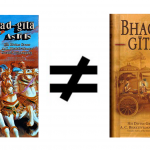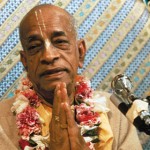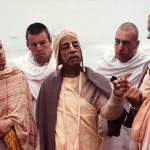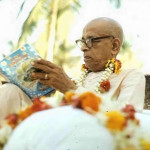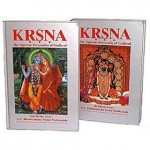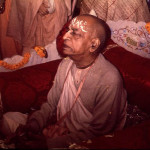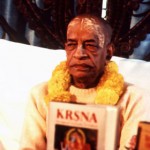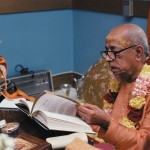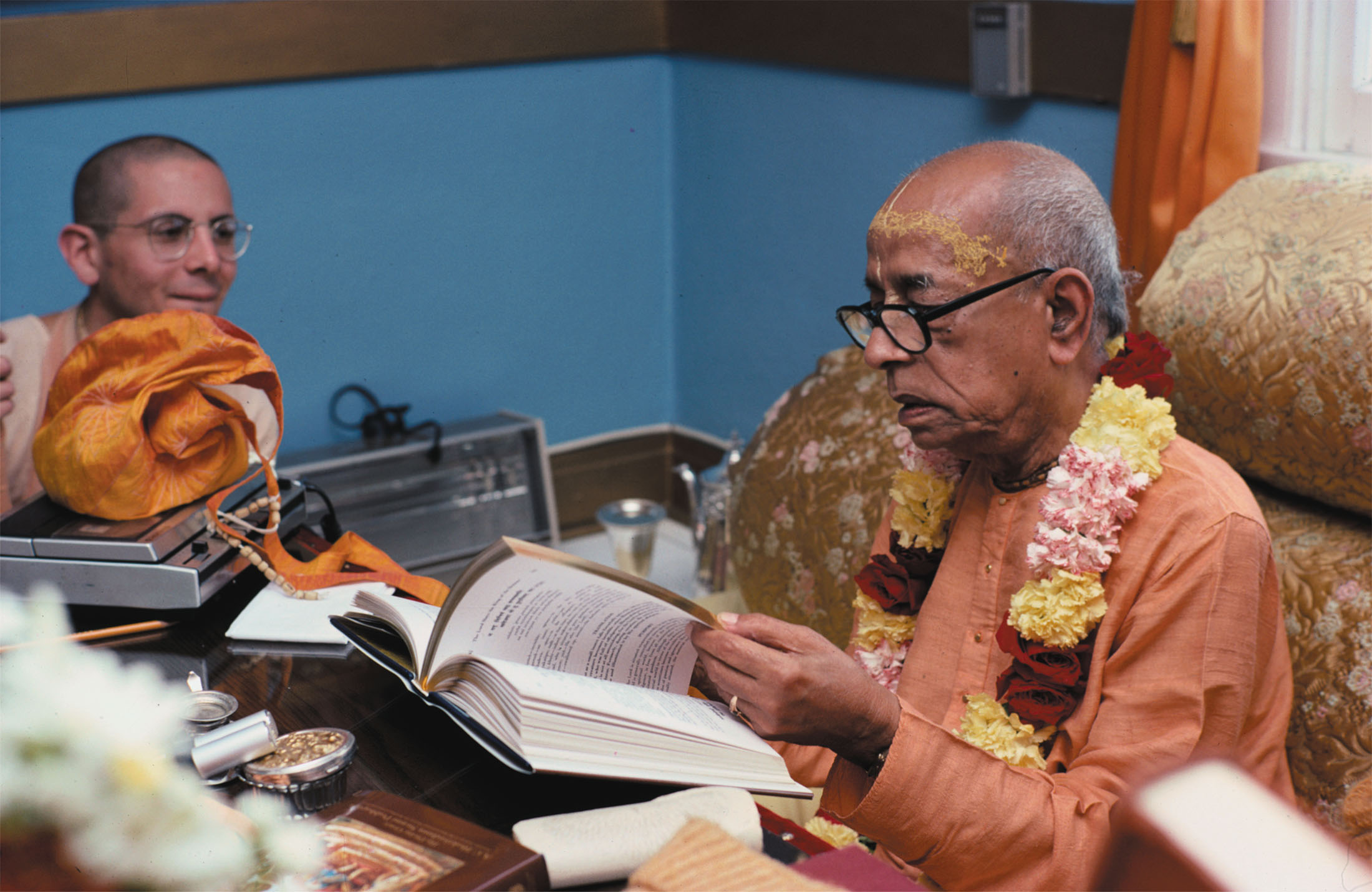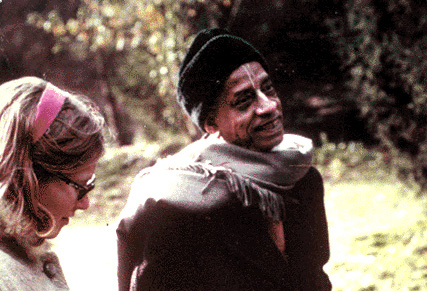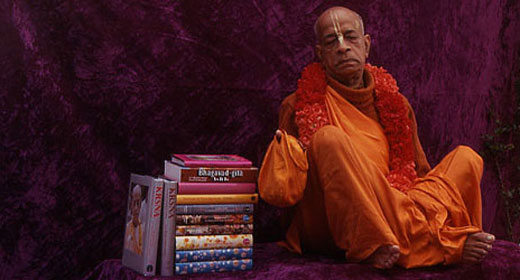
E-book about the changes made to Srila Prabhupada’s Books (VERSION 0.1).
The changes to Srila Prabhupada’s books that the BBT International does not want you to know about!
This e-book is made from articles from the website www.arsaprayoga.com. Please visit the above link for many more articles like the ones in this e-book. Please join the debate at FaceBook.
A heartfelt thanks to all devotees who have contributed to this e-book with their articles, knowledge, support and encouragement!
This e-book was released 26th April 2014. If you want to be sure you have the latest version of this e-book please download it from www.arsaprayoga.com.
INTRODUCTION
Many changes have been made to Srila Prabhupada’s books since his departure in 1977. As we all know this has caused a lot of controversy.
This e-book presents new evidence to the effect that the BBT International, and Jayadvaita Swami in particular, have overstepped their authority by making changes that Srila Prabhupada did not want.
This articles in this e-book will show you that the changes to Srila Prabhupada’s books cannot be justified by arguments like
- We are changing Srila Prabhupada’s books back to what he actually said in his original manuscript.
- We are making the book “Closer to Prabhupada”.
- We are only correcting grammar, commas, capitalization etc.
- We are only correcting the mistakes of previous editors
- No unnecessary changes have been made
- On the contrary, these articles will document that the BBT International have
- Deleted many of Prabhupada’s own chosen words and sentences (even those also found in his “original manuscript”)
- Added their own words and sentences (which means these word and sentences are also not to be found in the “original manuscript”)
- Changed Prabhupada’s own personally typewritten sanskrit translations.
- Made unnecessary change of syntax (sentence structure).
We humbly ask you can read this e-book, and also visit the website www.arsaprayoga.com for much more information and many more examples of changes to Srila Prabhupada’s books.
Thank you!

By Bhakta Torben and Ajit Krishna Dasa
Srila Prabhupada’s Bhagavad-gita 4.38, original 1972 edition:

Jayadvaita Swami’s version (BBT International, 1983 edition):

The sentence,
“And one who has achieved this enjoys the self within himself in due course of time.”
is changed to:
“And one who has become accomplished in the practice of devotional service enjoys this knowledge within himself in due course of time.”
This change is both needless and alters the meaning.
It is NEEDLESS because Prabhupada has not asked for it.
It alters the meaning, as the words “enjoys the self” is erased and replaced with “enjoys this knowledge”.
And the words “has achieved this” are substituted with “has become accomplished in the practise of devotional service”.
Furthermore the words “are culminated” in the end of the purport are NEEDLESSLY changed to “culminate”.
So there are NEEDLESS changes BOTH in the translation and in the purport.
Usually all this is explained away with something from the “original manuscript”. But on BBT International’s website we find no information about this change.
The “original manuscript” sounds like this:

So AGAIN the “original manuscript” is seen to be closer to the 1972 original Bhagavad-gita than Jayadvaita Maharaj’s version.
On top of that, in the word-for-word translation the word “na – never” is changed to “na – nothing” and “svayam-itself” is changed to “svayam-himself”. Prabhupada personally did ALL the type-writing for the first six chapters of the so called “original manuscript”. In the “original manuscript” Prabhupada’s translation of “na” was “never” (Na-never) and his translation of “svayam” was “itself” (svayam-itself):

So BBT International have CHANGED PRABHUPADA’S SANSKRIT TRANSLATION as it was PERSONALLY WRITTEN BY HIM, on his type writer. Prabhupada was very concerned with better knowing disciples that had become “learned” in sanskrit:
“…a little learning is dangerous, especially for the Westerners. I am practically seeing that as soon as they begin to learn a little Sanskrit immediately they feel that they have become more than their guru and then the policy is kill guru and be killed himself.” (from a letter to Dixit das on 18 Sep 1976)
Prabhupada gave this lecture from Bg. 4.38 and did not mention anything about changing anything:
Madhudvisa: Verse thirty-eight: “In this world there is nothing so sublime and pure as transcendental knowledge. Such knowledge is the mature fruit of all mysticism and one who achieved this enjoys the self within himself in due course of time [Bg. 4.38].”
Prabhupada: Yes. Knowledge: “I am part and parcel of Krishna, or God. My duty as part and parcel is to serve Krishna.” Just like this finger is the part and parcel of my body. The duty of the part and parcel is to serve.
(Bhagavad-gita 4.34-39, Los Angeles, January 12, 1969)
The original manuscript:

The authorized and approved 1972 edition:

The BBT International’s 1983 edition:

We can see that the BBT International have changed the word “owner” to “knower” in the second line. Why? Searching the BBT International’s website and the internet we have found no information on why this change was made.
Questions to the BBT International:
Before you changed Prabhupada’s Bhagavad-gita As It Is verse 13.3…
- Did you know that Prabhupada approved the galley proofs / the blueprint of the Bhagavad-gita As It Is, and according to Brahmananda Das (at that time swami) Prabhupada read the complete galley proofs before approving them to be sent to MacMillan to be used for printing what became the original and authorized 1972 edition of Bhagavad-gita As It Is?
- Did you know that Prabhupada lectured many times on BG 13.3, and that he did not object to the word “owner” in the translation? Did you know he actually reconfirmed the word “owner” by using it in these lectures?
Pusta Krsna:
ksetra-jnam capi mam viddhi
sarva-ksetresu bharata
ksetra-ksetrajnayor jnanam
yat taj jnanam matam mama
Translation: “O scion of Bharata, you should understand that I am also the knower in all bodies, and to understand this body and its owner is called knowledge. That is My opinion.”
Prabhupada: That is greatness. This is the distinction. God is great. I know about my body, you know about your body, but God knows about your body and my body and his body and every… That is greatness. (Evening Darsana — July 6, 1976, Washington, D.C.)
Hari-sauri:
ksetra-jnam capi mam viddhi
sarva-ksetresu bharata
ksetra-ksetrajnayor jnanam
yat taj jnanam matam mama
[Bg. 13.3]
Prabhupada: Ksetra-ksetrajnayor jnanam yat taj jnanam matam mama. English?
Hari-sauri: “O scion of Bharata, you should understand that I am also the knower in all bodies, and to understand this body and its owner is called knowledge. That is My opinion.”
Prabhupada: First of all knowledge means ksetra-ksetrajna. The body is the field of activity. You are acting, I am also acting, everyone is acting — according to the body. But the actor is called ksetrajna. Just like a cultivator is tilling the land, his own, and the tiller is cultivator. Similarly, this body is an analogy of this field, and we are tilling. So Krsna says that “I am also one of the tillers.” Just like the tenant and the landlord. In an apartment house, the tenant is occupier of a certain house, certain apartment, but the landlord is the owner of the whole house. So God says “I am also ksetrajna — but for all the buildings.” Everything that is there, all planets, all, everywhere. That is His all-pervasiveness. I am the proprietor of this body, owner of this body, but God is proprietor of all the bodies. In this way that is explained.” (Room Conversation with George Gullen, President of Wayne State University — June 15, 1976, Detroit)
“So people are taking this, that “I am this body.” That is ignorance. If they know, if one knows that “I am not this body; I am proprietor of this body, I’ll have to work with this body for my future,” then that is knowledge. Etad yo vetti ksetra-jna, knower, one who knows. That is the beginning of knowledge. Then Krsna says,
ksetra-jnam capi mam viddhi
sarva-ksetresu bharata
ksetra-ksetra-jnayor jnanam
yat taj jnanam matam mama
[Bg. 13.3]
Krsna is giving His opinion, the Supreme Authority, that “If you want to know, if you want to be in knowledge, this is knowledge.” What is that? “That this body, you are not this body; you are the owner of the body. And you should know also that the there is another person. As you are a person, you are owner of this body, there is another person.” Who is that? “That is I am.” Krsna says. Ksetra-jnam capi mam viddhi: “I am also owner of this body.” Actually Krsna is the owner of the body. Just like in a, in an apartment, there is the occupier and the landlord…Similarly, Krsna is the real owner of this body because Krsna has given me this body just to occupy it and work. So far. Not that I am the actual proprietor of this body.” (As the body is our field for cultivating Krsna conscious ness, so the land is our field for cultivating food…Vedic civilization means every man should produce his own food. More precise reference to be added soon)
Devotee: “O scion of Bharata, you should also understand that I am also the knower in all bodies and to understand this body and its owner is called knowledge. That is my opinion.”
Prabhupada: So Arjuna inquired from Krsna six things: ksetra, ksetrajna, prakrti, purusa, jnanam, jneyam. What is knowledge and what is the object of knowledge. (Bhagavad-gita 13.3 — Paris, August 11, 1973)
Nitai: Translation: “O scion of Bharata, you should understand that I am also the knower in all bodies, and to understand this body and its owner is called knowledge. That is My opinion.”
Prabhupada:
ksetra-jnam capi mam viddhi
sarva-ksetresu bharata
ksetra-ksetra-jnayor jnanam
yat taj jnanam matam mama
[Bg. 13.3]
Jnanam, knowledge. The Supreme Personality of Godhead Krsna is explaining about knowledge. People are being educated all over the world for advancement of knowledge. Knowledge is meant for the human being, not for the cats and dogs. Therefore, for human being, there are so many universities, schools, colleges, institutions, laws. There are so many things (indistinct) to advance knowledge is to understand “Who am I?” If I do not know who am I, then what is the meaning of my advancement of knowledge? Generally, despite so many universities all over the world, people are going on in the concept of this body, “I am this body.” “I am Indian,” “I am American,” “I am Hindu,” “I am Muslim.” So everyone is identifying himself with this material body. Then where is the advancement of knowledge? Here Krsna says, ksetra-ksetra-jnayor jnanam yad jnanam, taj jnanam matam mama. The ksetra, this body, and the owner of the body… I am not this body, I am the owner of this body. This is jnanam. (Bhagavad-gita 13.3 — Hyderabad, April 19, 1974)
- Did you know that Prabhupada used the words “knower”, “owner”, “occupier” and “proprietor” many times for both the soul and Krishna? And many times when referring specifically to BG 13.3? And did you know that Prabhupada often translated ksetra-jna as both the “knower of the body”, “owner of the body”, “possessor of the body” and “proprietor of the body”?
“But there is another living being. He is supreme living being, Krsna. He says that “I know everything of everyone’s body.” Ksetra-jnam capi mam viddhi sarva-ksetresu bharata [Bg. 13.3]. This is the verse. Ksetra-jna means the knower of the body. You are individual knower of your body; I am knower individually of my body. ” (Lecture at Boys’ School — Sydney, May 12, 1971)
“In Bhagavad-gita it is said, ksetra-jnam capi mam viddhi sarva-ksetresu bharata [Bg. 13.3]. Everything is there. The ksetra-jna means the possessor of this ksetra, body, the owner or occupier. ” (Bhagavad-gita 7.3 — London, March 11, 1975)
“The ksetra jna, the owner of the body, is also called the khaga, the living entity. Within the body there are two such ksetra jnas — the individual soul and the Supersoul. The individual soul is the owner of his individual body, but the Supersoul is present within the bodies of all living entities.” (SB 10.2.27)
“In another place, Krsna says this dehi or ksetra-jna, the owner of the body is there, and there is another ksetra-jna, another owner. That is Krsna. Ksetra-jnam capi mam viddhi sarva-ksetresu bharata [Bg. 13.3]. As the individual soul is there within the body, similarly, the Supersoul, Krsna, is also there.” (Bhagavad-gita 2.30 — London, August 31, 1973)
“In another place also Krsna says ksetra-jnam capi mam viddhi sarva-ksetresu bharata [Bg. 13.3]. The question of the ksetra-jna, the owner of the body and the body. In this Chapter, in the Thirteenth Chapter, it is discussed. So in that chapter Krsna says that “I am also one of the owner of the body,…”” (Bhagavad-gita 9.3 — Toronto, June 20, 1976)
“In the Bhagavad-gita Krsna says, ksetrah ksetra-jnah. Ksetra-jnam capi mam viddhi sarva-ksetresu bharata [Bg. 13.3]. Ksetra-jna means the proprietor of the ksetra, this body. Body is called ksetra. So I am proprietor.” (Srimad-Bhagavatam 3.25.4 — Bombay, November 4, 1974)
(For more references please search the Vedabase/folio for these key words in relation to BG. 13.3. There are too many examples to include them all here).
The BBT International can’t justify this change from “owner” to “knower” in BG 13.3 by referring to the so called original manuscript, Prabhupada’s desires, to faulty sanskrit translation, to meaning, to spelling or to grammar.
Then how will they justify it?

In regard to the posthumous editing of Prabhupada’s Bhagavad-gita As It Is, Jayadvaita Swami has expressed (emphasis added by Arsa-Prayoga staff):
1982:
“Comparing each verse in the book with the text of the manuscript, I made only those changes that to me seemed worthwhile. I tried to be conservative and not make needless changes. ” (Jayadvaita Swami, letter to senior devotees, October 25, 1982)
1986:
“As you know, and as we kept in mind while doing the work, Srila Prabhupada staunchly opposed needless changes. ” (Jayadvaita Swami, Letter to Amogha Lila, 1986)
1995:
“When Srila Prabhupada conveyed to us the conclusions of the previous acaryas, he did so perfectly, preserving and transmitting the philosophy exactly as it is, neither watering anything down, nor covering anything over, nor leaving anything out. He gave us the essence of everything.
We therefore don’t need to add anything, subtract anything, or change anything. We need only faithfully serve Srila Prabhupada’s orders, and everything will be revealed.” (Jayadvaita Swami, Sri Vyasa Puja book August 19,1995)
2009:
On BBT International’s website we find this video: https://www.youtube.com/watch?v=fTjrZvX_Hlc
Transcription of the video:
“Arsa-Prayoga is a very important principle. The editor should never have the mentality that he’s better than the author, that he has something more to contribute than the author does, that the author really doesn’t know what he is doing, but he knows what he is doing. That’s offensive! And that is…ruins everything! It is an offense to the acarya. The idea, however, that this sort of sanctity that the author’s text has, or that the words of the author have, somehow extends to the mistakes of the editors…is weird! “It’s an offense to correct the mistakes of previous editors!” Are they acaryas? Are they paramahamsas? Are they infallible? They are wonderful devotees, they did wonderful service. But they made mistakes. Understandably.”
Summing up Jayadvaita Maharaja’s standpoints from the above:
In 2009 Jayadvaita Swami admits that the principle of arsa-prayoga is very important, and that it is an offense to violate it. He admits that Prabhupada’s text has sanctity, and that the editors of Prabhupada’s books should never think they are better than Prabhupada and has more to contribute than Prabhupada.
In 1995, twelve years after Prabhupada’s disappearance, Jayadvaita Swami said that we should not add, subtract or change anything in the teachings Prabhupada has given us. Earlier, in 1982 and 1986, Jayadvaita Swami claimed that they had in mind not to make needless changes in their editing of Bhagavad-gita As It is, because Prabhupada staunchly opposed such needless changes. They only changed what they felt was worthwhile changing. However, Jayadvaita Swami further states that the sanctity that Prabhupada’s texts have do not apply to the work done by Prabhupada’s editors (he seem not to appreciate the fact that this work was later approved by Prabhupada. Does Prabhupada’s approval not have sanctity?)
In this way Jayadvaita Swami makes it seem as if he did not add, subtract or change any of Prabhupada’s direct words (except for the grammatical errors, capitalisation and commas). However, during the last three decades, we and many other devotees have observed and documented numerous needless changes made by Jayadvaita Swami to Prabhupada’s Bhagavad-gita As It Is. And in spite of Jayadvaita Swami’s own seeming interest in not adding, subtracting or changing anything in Srila Prabhupada’s teachings, the posthumously edited books contain all of these three types of edits (adding, subtracting and changing).
We will now start a series of articles documenting the changes made to the sanskrit synonyms (word for word meanings) in the first six chapters of the Bhagavad-gita As It Is. Why only the first six chapters?
According to Jayadvaita Swami the first five or six chapters of the draft (often referred to as the “original manuscript”) to the Bhagavad-gita As It Is was personally typewritten by Srila Prabhupada himself.
Jayadvaita Swami writes on his website:
“Some books Srila Prabhupada wrote out in longhand or typed himself. These include Easy Journey to Other Planets, Sri Isopanishad, the first and second cantos of Srimad-Bhagavatam, the first five or six chapters of Bhagavad-gita As It Is,…” (Jayadvaita Swami, Editing the Unchangeable Truth, How Were the Books Written?, Reprinted from ISKCON Communications Journal, Volume 11, 2005)
If anything has sanctity, apart from the finished manuscripts that Prabhupada sent to the press for printing, it must be the words that he himself wrote on his type-writer. We would most certainly not expect to see any changes made to these. Even if they contain mistakes, these mistakes should not be corrected according to the principle of arsa-prayoga.
However, we do see significant changes made to the sanskrit translations that Prabhupada personally wrote on his type-writer. By comparing the posthumously edited 1983 edition with both the 1972 MacMillan edition and the so called “original manuscript” we see that the 1972 MacMillan edition is much closer to and faithful to Prabhupada’s original words.
This is especially interesting because Prabhupada was very concerned with better knowing disciples that had become “learned” in sanskrit:
“…a little learning is dangerous, especially for the Westerners. I am practically seeing that as soon as they begin to learn a little Sanskrit immediately they feel that they have become more than their guru and then the policy is kill guru and be killed himself.” (from a letter to Dixit das on 18 Sep 1976)
We now publish for the first time a complete list over all the changes made to Prabhupada’s personally type-written sanskrit translations. Here is the complete list for Chapter One.
Direct link: https://www.dropbox.com/s/gz0t7i0fkt1w9bp/bg-comparing-OM-1972-1983-ch1.pdf
Or: http://arsaprayoga.com/?attachment_id=1265

Here we are presenting some statistics by dividing the changes into different categories.
Some statistics
We have categorized the changes presented in the below PDF-file, so it is easier to see what was actually done by the BBT International. It must be noted that some changes fall into more than one category.
There are also some subtleties in the way the categorization has been done. For example, Prabhupada used a regular typewriter and was therefore not able to write the diacritic marks. So if the diacritic marks are missing in Srila Prabhupada’s draft, but they are added in the 1972 Macmillan edition that is not counted as a change.
Srila Prabhupada started all sanskrit synonyms with capital letters in the draft. In the both the 1972 and 1983 editions they were not written with capital letters. This has not been counted amongst the changes.
Other things not counted as a change is when Srila Prabhupada, while writing his draft, obviously hit a wrong letter on his keyboard. An example of this would be “bcpmes” instead of the correct “becomes”. “O” and “p” are just besides each other on a keyboard.
I did my very best, and I tried to be as kind as I could to BBT International, but I encourage everyone to double check my work and get back to me if they think anything could have been done better.
This is how we did it:
Modifications 1: Spelling mistakes, commas, punctuation marks, dividing or connecting sanskrit words and their synonyms:
Result: 23 (17,03%)
It should be noted that no changes that had to do with spelling, commas and punctuation marks were found. Therefore all changes here have to do with dividing and/or connecting sanskrit words.
Modifications 2: Modifications according to Srila Prabhupada’s draft while the original edition does not follow Srila Prabhupada’s draft:
Result: 6 (4,44%)
Here is should be noted that four of these six changes have to do only with connecting and dividing sanskrit words. All four are similar to this (left: draft, middle: 1972 edition, right: 1983 edition):

The other two changes back to the draft were actual changes of English translation, though minor.
Modifications 3: Modifications not according to Srila Prabhupada’s draft while the original edition also does not follow Srila Prabhupada’s draft.
Result: 15 (11,11%)
Modifications 4: Modifications not according to Srila Prabhupada’s draft while the original edition follows Srila Prabhupada’s draft.
Result: 89 (65,92%)
Modifications 5: Modification where the word was missing from Srila Prabhupada’s draft.
Result: 2 (1,48%)
Here is the PDF with all changes for BG, Chapter One:
Direct link: https://www.dropbox.com/s/gz0t7i0fkt1w9bp/bg-comparing-OM-1972-1983-ch1.pdf
Or: http://arsaprayoga.com/?attachment_id=1265

“In the old edition, the idea of a specific military formation (vyudham) is omitted.”
So we see that Jayadvaita Swami feels free to not only override Prabhupada’s editorial decisions regarding Bg. 1.2, namely to omit “military phalanx”, but also to unnecesarrily add the word “formation” instead of “phalanx” (Prabhupada often used the word phalanx. We find it many times in books like Bhagavad-gita, Krishna Book, Nectar of Devotion, Caitanya Caritamrta, and also in lectures, conversations, earlier essays and poems).
Jayadvaita Swami continues:
“In the new edition, I revised “phalanx” to “military formation” because a phalanx (originally) is a particular type of formation peculiar to ancient Greek warfare. Greek columns on the Battlefield of Kuruksetra didn’t seem right. Hence the revision.”
Then why did Jayadvaita Swami not remove the word “phalanx” from Bg. 1.11?
“All of you must now give full support to Grandfather Bhisma, as you stand at your respective strategic points of entrance into the phalanx of the army.” (Bg, 1.11, BBT International 1983 edition)
“Phalanx” is also found in the purports to Bg. 1.3 and Bg. 1.11 in BBT International’s 1983 edition.
Something doesn’t make sense!
Jayadvaita Swami ends:
“In retrospect: “Phalanx” has come to refer to any military formation, so perhaps I should have been less picky. But at any rate, the new translation gets in the idea that the old one left out.”
So will Jayadvaita Swami again add the word phalanx to Bg. 1.2? Or will he remove it from Bg. 1.11 and add “formation”? Changing back and forth – again and again and again…ad infinitum?
Is that what Prabhupada expected from his editors? Is this how the world comes to respect Prabhupada’s books and ISKCON?
“As you know, and as we kept in mind while doing the work, Srila Prabhupada staunchly opposed needless changes.” (Jayadvaita Swami’s Letter to Amogha Lila 1986)
“Comparing each verse in the book with the text of the manuscript, I made only those changes that to me seemed worthwhile. I tried to be conservative and not make needless changes.” (Jayadvaita’s letter to senior devotees, October 25, 1982)
From the so called “original manuscript”:

From the original and by Prabhupada approved/authorized 1972 edition of Prabhupada’s Bhagavad-gita As It Is:

From the BBT International’s 1983 posthumously edited Bhagavad-gita As It Is:

“PHALANX” – JAYADVAITA SWAMI’S DOUBLE STANDARD
Jayadvaita Swami attempts to justify his changes in this way:
“In the old edition, the idea of a specific military formation (vyudham) is omitted. In the new edition, I revised “phalanx” to “military formation” because a phalanx (originally) is a particular type of formation peculiar to ancient Greek warfare. Greek columns on the Battlefield of Kuruksetra didn’t seem right. Hence the revision. In retrospect: “Phalanx” has come to refer to any military formation, so perhaps I should have been less picky. But at any rate, the new translation gets in the idea that the old one left out.
We see that Jayadvaita Swami feels free to not only override Prabhupada’s editorial decisions regarding Bg. 1.2, namely to omit “military phalanx”, but also to unnecesarrily add the word “formation” instead of “phalanx” (a word Prabhupada often used).
Bg, 1.11 (BBT International 1983 edition):
“All of you must now give full support to Grandfather Bhisma, as you stand at your respective strategic points of entrance into the phalanx of the army.”
According to Jayadvaita Swami: in Bg. 1.2 “phalanx” didn’t seem right on Kuruksetra, because it’s a Greek word peculiar to ancient Greek warfare. But in Bg. 1.11 Jayadvaita Swami did not remove “phalanx”.
What are we to make of it?
Jayadvaita Swami admits that he might have been a little too “picky” regarding the word “phalanx”. This means he is not completely satisfied with his own work. Maybe we will have a new edition of Bg. 1.2 in his next printing? And what about Bg. 1.11? Change-change back-change-change back? Is that what Prabhupada wanted?
Jayadvaita Swami said he tried not to make needless changes, but only those worthwhile. But which of the changes here are really worthwhile? Which are really needed? None of them! Bg. 1.2 is just fine the way it is in the original 1972 edition.
“BEGAN TO SPEAK”
Jayadvaita Swami continues:
“Srila Prabhupada typically said “began to speak” or “began to say” when the meaning is simply “spoke” or “said.” Such a phrase as “began to speak” is more apt when followed by something like “but was cut off” or “but changed his mind and fell silent.” In later books, the BBT editors routinely trimmed off the “began to.”
The expression “began to speak” is not wrong, and as we can see below Prabhupada did not object to it in Bg. 1.2, but re-confirmed it. Therefore the change is needless and not at all worthwhile. The editors might have trimmed the phrase off in other books, but these books were then approved by Prabhupada. Bg. 1.2 was approved with the phrase “began to speak”. Prabhupada did not approve the 1983 edition.
The shocking fact is that Jayadvaita Swami’s underlying technique is to attempt to mind-read Prabhupada after his physical disappearance and use his mind-reading “discoveries” about Prabhupada’s desires in relation to his books to change them posthumously. I don’t think even the devotees in favor of the changes have the fantasy to imagine that this is an editing methodology actively used by the BBT International.
The fallacy of going back to the so called original manuscript is covered here. But apart from that, what does it even mean to postulate that you are changing back to the manuscript, when there are so many instances where you concoct phrases that Prabhupada never used in relation to the verses under discussion?
Let us see how Prabhupada dealt with Bg. 1.2:
Pradyumna: (leads chanting, etc.)
sanjaya uvaca
drstva tu pandavanikam
vyudham duryodhanas tada
acaryam upasangamya
raja vacanam abravit
[Bg. 1.2]
Translation: “Sanjaya said: O King, after looking over the army gathered by the sons of Pandu, King Duryodhana went to his teacher and began to speak the following words:”
Prabhupada: So Dhrtarastra inquired from Sanjaya, kim akurvata: “After my sons and my brother’s sons assembled together for fighting, what did they do?”
Prabhupada continues without objecting to the words “began to speak. In fact a little later in the same lecture Prabhupada says:
“Raja vacanam abravit [Bg. 1.2]. Then he began to speak, to inform Dronacarya.”
(Bhagavad-gita 1.2-3, London, July 9, 1973)
So in this lecture Prabhupada heard the verse, and did not object to to words “gathered” and “began to speak”. In fact he re-translated the words “raja vacanam abravit” to “began to speak” – the very same words he used in his draft (so called original manuscripts) and which he had approved in his 1972 edition of Bhagavad-gita As It Is.
From a room conversation:
Aksayananda: Acaryam upasangamya raja vacanam abravit [Bg. 1.2].
Prabhupada: Yes. What is the translation?
Aksayananda: “Sanjaya said, ‘Oh king after looking over the army gathered by the sons of Pandu, King Duryodhana went to his teacher and began to speak the following words.’ ”
Prabhupada: Aiye. [break] Caitanya Mahaprabhu’s mission is to preach. So you join us.
(Room Conversation on New York court case, November 2, 1976, Vrindavana)
Prabhupada continues speaking with no objection to the verse as it was read to him.
The comparison of Bg. 1.2 in the original 1972 edition and BBT Internationals 1983 posthumously edition version is an axample of everything Prabhupada’s editors should NOT do:
- They changed what was approved by Prabhupada (namely “gathered” and “began to speak”)
- They added what Prabhupada approved left out (namely “military”)
- then added something Prabhupada didn’t write (namely “formation” instead of “phalanx” and “spoke” instead of “began to speak”).
Jayadvaita Swami is not at all being conservative in his editing. He is by nature an extreme liberal, since he feels free to rely on a New Age methodology, namely using his feelings and “intuition” to mind-read Prabhupada. Jayadvaita Swami is actively using this liberal New Age methodology to add, substract, concoct and change words in Prabhupada original and authorized books.
“Time I am, Destroyer of the worlds, and I have come to engage all people…”
Unauthorized 1983 edition:
“Time I am, Destroyer of the worlds, and I have come here to destroy all people…”
Why has Jayadvaita Swami exchanged the word “engage” with the word “destroy”? There is no explanation for this particular change on the BBTI’s website.
Sanskrit synonyms says to engage twice:

The so called original manuscript is missing for this part of the gita, so no claim can be made that this change is “closer to Prabhupada”. On the contrary it seems to be what Srila Prabhupada wanted, since he made no objections when he heard the text to verse 11.32:
Giriraja: (reads synonyms for following verse:) “Translation: The Blessed Lord said: Time I am, destroyer of the worlds, and I have come to engage all people. With the exception of you, the Pandavas, all the soldiers here on both sides will be slain.” Dr. Patel: Shall I read further, sir, or you want to comment? Prabhupada: Yes. The process is going on. Although we have got so many plans to save, nobody can be saved. The destination, the bhutva bhutva praliyate [Bg. 8.19], that will go on. Simply vita-raga-bhaya-krodha man-maya mam upasritah [Bg. 4.10], they will be saved. Otherwise all finished.
We would like to hear from Jayadvaita Swami and the BBT International what the explanation for this change is?
“BY: A GROUP OF SRILA PRABHUPADA DISCIPLES & FOLLOWERS
Dear Jayadvaita Swami, Dravida Prabhu & Company, please explain why you have done the following:
(1) Why is it in the revised edition of the Bhagavad-gita, you and company have completely removed the foreword by Professor Edward Dimock that was printed in the original Macmillan version of the Bhagavad-gita As It Is which Srila Prabhupada regularly read from?
Readers, please visit the website and see the video on YouTube of Srila Prabhupada lecturing on the Bhagavad-gita.
There, in the very immediate beginning (very first few minutes) of this video, you will find Srila Prabhupada praising the foreword by Professor Edward Dimock. This particular video clip is taken from one of the 19 Double layer DVD’s produced by Nrsimhananda Prabhu and his associates at ITV. It is the particular DVD named Bhagavad Gita as It Is, with Krishna and Arjuna on the chariot, and sky background, and is in the very first part, called “Introduction”.
Srila Prabhupada is reading the foreword himself, praising it, mentioning Edward Dimock’s name, and praising Edward Dimock for a particular comment that he had made, as follows:
“Swami Bhaktivedanta comments upon the Gita from this point of view, and that is legitimate. More than that, in this translation the Western reader has the unique opportunity of seeing how a Krsna devotee interprets his own texts”
Srila Prabhupada in the video explains this particular statement by Edward Dimock, on how a Krsna devotee interprets his own texts, by explaining that just as a family member only is qualified to give the best knowledge to others about his own family, similarly, only a Krsna devotee can properly explain to others about Krsna. Srila Prabhupada appreciates this particular point made by Edward Dimock in the video.
Thus, not only has Srila Prabhupada authorized this particular foreword in the Macmillan Bhagavad-gita, but had himself read, it, and praised certain points made by the person who wrote this foreword. Yet you, Jayadvaita Swami, Dravida Prabhu & Company, have the audacity to remove this foreword completely in your revised version. The proof of how you have offended your Spiritual Master is on public video record, as those who watch will sadly but easily be able to understand this particular deviation of yourselves in either revising or omitting your Spiritual Master’s works and words by using your fertile imaginations.” [End of excerpt]
Below there are several instances where Prabhupada shows appreciation for the foreword by Edward Dimock. Please note that Prabhupada said that this foreword will “appeal to the scholarly class”. And we see here that Prabhupada in fact used the foreword to preach to professors, scholars, cardinals and journalists. As can be seen from the below quotes Prabhupada appreciated the foreword because it underscored some of his own points about this specific edition of the Bhagavad-gita, namely the As It Is version.
But the BBT International under the leadership of Jayadvaita Swami have now removed this foreword by Professor Dimock without ever explaining why. Certainly Prabhupada never asked for its removal.
Prabhupada: That’s all. So this Bhagavad-gita, at least, should be introduced in all colleges. And Professor Dimock has recommended. Just…
Professor: Well, it is quite widely read, the Bhagavad-gita.
Prabhupada: Eh?
Professor: The Bhagavad-gita is quite widely read.
Pradyumna: This is an introduction by Professor Dimock.
Professor: Yes, I’ve seen it. I read it. But it is quite widely read, you know. I mean the translations…
(Room Conversation with Sanskrit Professor, Dr. Suneson — September 5, 1973, Stockholm)
Prabhupada: That has been written by Professor Dayal, Dimock, that “Sanskrit scholars should get good opportunity, and nobody, I think, will deny Swamiji’s scholarship.” He has said that. (Room Conversation — September 21, 1973, Bombay)
Bhagavan: There are many copies of Bhagavad-gita, but the unusual happening with this version is until this was presented, there was no devotee…
Prabhupada: Professor Dimock has said very nicely.
Monsignor Verrozano: Yes, we have also many translations. Yes.
Prabhupada: You have not brought by the fruit?
Nitai: Yes, Satsvarupa Maharaja did.
Monsignor Verrozano: We have here one translation of the commentary of Professor Zehner(?) from Oxford.
Prabhupada: Here is my foreword by Professor Dimock.
Yogesvara: This is a professor from Chicago University who wrote the foreword to this edition. He makes an interesting comment.
Prabhupada: You read, read it.
Dhananjaya: Yes.
Prabhupada: Professor Dimock’s.
Cardinal Pignedoli: It’s very strange and famous. That’s the gospel.
Prabhupada: Read it.
Dhananjaya: (reading) “Swami Bhaktivedanta comments upon the Gita from this point of view. And that is legitimate.”
Prabhupada: Yes. That is legitimate.
Dhananjaya: “More than that, in this translation the Western reader has the unique opportunity of seeing how a Krsna devotee interprets his own texts. It is a Vedic…”
Cardinal Pignedoli: Yes.
Prabhupada: A Krsna devotee interpreting on Krsna, and a nondevotee interpreting on Krsna. There is far difference. (Room Conversation with Catholic Cardinal and Secretary to the Pope — May 24, 1974, Rome)
The introduction by Mr. Dimock is nice and it will appeal to the scholarly class. (Letter to: Rupanuga — Sydney 4 April, 1972)
Krishna is the source of all human cultural contributions, and His book is the most widespread read all over the world. So if you can convince this education minister that this KC Movement is cultural. One big, big Professor Dimock has given in his introduction to my Bhagavad-gita As It Is that every college student should read this book. Syamasundara. can send you a copy of his statement if you require. So if in other colleges beyond India it is so recommended, why not in India. So the education minister must advise this books should be read. This will give us example for approaching central government. There are so many things to be done. (Letter to: Giriraja — Sydney 12 April, 1972)
Speculators cannot have definite knowledge. Therefore our Professor Dimmock has said, “Here is definite definition of Gita.” What is that? Just see. Then it is so. He has appreciated it. You cannot see, of the…
Devotee: They only put two lines of what he said in there. He says this…
Prabhupada: Yes. That is his word.
Devotee: Oh.
Prabhupada: Read it all.
Devotee: “Definitive English edition of Bhagavad-gita. By bringing us a new and living interpretation of the text already known to many, A.C. Bhaktivedanta Swami Prabhupada has increased our own understanding manyfold.”
Prabhupada: That is a definite, not vague, speculative. That is the difference between my translation and others. Therefore I have given the name “As It Is.” So we will be no spoke or speculation. As soon as you speculate, you are rejected. Therefore others are seeing some danger that “This Bhaktivedanta’s…, this Bhagavad-gita As It Is accepted, then where we are?” (George Wilhelm Friedrich Hegel)
Prabhupada: “Dimmock. He has given very good appreciation. And gradually it will be printed in other languages. German, French, Spanish, Denmark, Holland…” (Conversation with Dai Nippon — April 22, 1972, Tokyo)
Prabhupada: “Somehow or other.” This is science. “Somehow or other,” “maybe,” “perhaps.” This is their science. [break] …speculation. The whole Western countries, their all knowledge simply speculation. Nothing definite. [break] …Professor Dimmock has “Definitive…” What is that translation, or something like?
Harikesa: Definitive.
Prabhupada: Definitive, then translation of Bhagavad-gita, like that. [break] (Morning Walk — June 30, 1975, Denver)
Prabhupada: Yes, yes, yes. You just read one big professor’s remark here. You see?
Faill: Yes.
Prabhupada: Professor Dimmock of Chicago University.
Faill: “A new and living interpretation.” This is you, is it?
Prabhupada: This is…? Yes.
Faill: That’s you.
Prabhupada: Yes. If you read these books and write regular articles on the basis of my talk with you, it will be actually great benefit to the public. (Room Conversation with Bill Faill (reporter) — October 8, 1975, Durban)
Pusta Krsna: In the United States… These are many letters we have, just some of them, from different professors who are actually using Prabhupada’s books, professors from respectable universities such as Harvard, Yale, Duke. Professor Dimmock, who is the leading scholar of southeastern languages at the University of Chicago, he very much appreciates Prabhupada’s books.
Prabhupada: He has written one foreword.
Pusta Krsna: So these books are being accepted as the authority, at least in America and England, so far as studies of Indian culture are concerned, philosophy, sociology. And you can see the beautiful presentation. Each Sanskrit is there, transliteration so that anyone can chant, word-for-word Sanskrit to English translation, translation in English, and then the purport, a commentary.
Prof. Olivier: That’s right. This is a good edition. Good edition.
Pusta Krsna: Professor Dimmock, he says that there are many, many translations of Bhagavad-gita, and he says that “By bringing us a new and living interpretation of a text already known to many, A.C. Bhaktivedanta Swami Prabhupada has increased our understanding manyfold.” So although it’s been prevalent in America… I know that when I was studying Humanities in college in the University of Florida, Bhagavad-gita was required. And we read one edition, but it was very much limited. Until we come in contact with Bhagavad-gita As It Is, the understanding is very much limited. But it’s not a sectarian approach. It’s purely scientific and realistic. There are many such reviews.
Prof. Olivier: Well, this is a good letter. (Room Conversation with Professor Olivier — October 10, 1975, Durban)
Prabhupada: Therefore rascal. (laughter) Therefore rascal. We definitely know Krsna, the origin of everything. That is definite, not “It may be.” We don’t say “Krsna may be.” No. Definitely. Krsnas tu bhagavan svayam [SB 1.3.28]. Here is Bhagavan. Here is God. That is definite. Therefore our professor…
Hamsaduta: Svarupa Damodara?
Prabhupada: No, no. Who has written foreword to my Bhagavad-gita?
Harikesa: Dimmock.
Prabhupada: Dimmock. “Here is definitive…”
Hamsaduta: Version.
Nitai: “Definitive edition.”
Prabhupada: “Definitive edition.” That is the credit. Not “may be.” No “maybe,” sir. That is rascaldom. (Morning Walk — November 26, 1975, New Delhi)
Prabhupada: Dimmock said that “Here is the commentation who has practiced devotion in his life.” (Morning Walk — December 17, 1975, Bombay)

Dec 20, 2013 — DENMARK (SUN) — The sixth chapter of Srila Prabhupada’s original Bhagavad-gita is called “SANKHYA-yoga”. And Prabhupada often spoke of the sixth chapter like that. Here are a few examples:
“That is the perfection of yoga. When Krsna has advised yoga practice, sankhya-yoga… You have Bhagavad-gita? There is -SANKHYA-yoga. You’ll find in the forty-seventh verse. This is the version.”
(Room Conversation – May 10, 1969, Columbus, Ohio)
In the Sixth Chapter He has explained the SANKHYA-yoga system and the concluding portion of the sankhya-yoga system is:
yoginam api sarvesam
mad-gatenantar-atmana
sraddhavan bhajate yo mam
sa me yuktatamo matah”
(Bhagavad-gita 6.47 – Ahmedabad, December 12, 1972)
“Thus end the Bhaktivedanta Purports to the Sixth Chapter of the Srimad-Bhagavad-gita in the matter of SANKHYA-yoga Brahma-vidya.”
(Bg AII 6.47)
“Thus ends the Bhaktivedanta Purports for the Sixth Chapter of Srimad Bhagavad Gita, in the matter of SAMKHYA yoga Brahma vidya”
(Prabhupada’s draft)

(Path of Perfection 1: Yoga as Action)
“…Thus end the Bhaktivedanta purports to the Fifth Chapter of the Srimad Bhagavad-gita on the subject of karma-yoga or acting in Krsna consciousness.”
Prabhupada: All right. Then we shall… SANKHYA-yoga shall I begin today or next day? This is a new chapter, we shall begin next day. (end)”
(Bhagavad-gita 5.26-29 – Los Angeles, February 12, 1969)
“That means one who is keeping always in Krsna consciousness, “abides in Me with great faith, worshiping Me in transcendental loving service is most intimately united with Me in yoga, and is the highest of all.” This is the prime instruction of this chapter, SANKHYA-yoga, that if you want to become perfect yogi of the highest platform, then keep yourself in Krsna consciousness and you become the first-class yogi.”
(Bhagavad-gita 6.46-47 — Los Angeles, February 21, 1969)
That is also stated in the SANKHYA-Yoga chapter of Bhagavad-gita:
yoginam api sarvesam
mad-gatenantar-atmana
sraddhavan bhajate yo mam
sa me yuktatamo matah
[Bg. 6.47]
(Bhagavad-gita 7.1 – Calcutta, January 27, 1973)
BUT BUT BUT
Jayadvaita Swami’s changed Bhagavad-gita So-called As It Is, which says DHYANA-yoga for the sixth chapter IN SPITE of Srila Prabhupada calling it SANKHYA-yoga in many, many places.
Question arises: This seems such a NEEDLESS change. How dare one correct Srila Prabhupada on this one?
Your servant, no ill intended,
Bhakta Torben
Here we post many more examples where Prabhupada says that the sixth chapter of Bhagavad-gita As It Is deals with sankhya-yoga:
“So we have been discussing Bhagavad-gita. In Second Chapter, the Lord has very elaborately explained the constitutional position of the living entity, and the whole first portion of the Six Chapter. The Bhagavad-gita is divided into three portions. The first six chapter, the second six chapters and the third six chapters. Actually just like this book, there are two hard covers, and in the middle there is the substance, writing. So the first six chapters, they are just like two coverings. Karma-yoga and jnana-yoga. And the middle six chapters, well-protected, that is bhakti-yoga. So at the end of the first six chapters, Krsna concludes the yoga system. In the Sixth Chapter He has explained the sankhya-yoga system and the concluding portion of the sankhya-yoga system is:
yoginam api sarvesam
mad-gatenantar-atmana
sraddhavan bhajate yo mam
sa me yuktatamo matah”
[Bg. 6.47] >>> Ref. VedaBase => Bhagavad-gita 6.47 — Ahmedabad, December 12, 1972
“Thus end the Bhaktivedanta Purports to the Sixth Chapter of the Srimad-Bhagavad-gita in the matter of Sankhya-yoga Brahma-vidya. ” >>> Ref. VedaBase => Bg 6.47
“Lord Caitanya’s teachings are identical to those given by Lord Kapila, the original propounder of sankhya-yoga, the sankhya system of philosophy. This authorized system of yoga recommends meditation on the transcendental form of the Lord. There is no question of meditating on something void or impersonal. One can meditate on the transcendental form of Lord Visnu even without practicing involved sitting postures. Such meditation is called perfect samadhi. This perfect samadhi is verified at the end of the Sixth Chapter of the Bhagavad-gita, where Lord Krsna says, “And of all yogis, the one with great faith who always abides in Me, thinks of Me within himself, and renders transcendental loving service to Me-he is the most intimately united with Me in yoga and is the highest of all. That is My opinion.”” (Bg. 6.47) >>> Ref. VedaBase => Cc. 1975-Preface
“It is our duty to act in Krsna consciousness because we are constitutionally parts and parcels of the Supreme. The parts of the body work for the satisfaction of the entire body, not for the individual parts. The goal is the satisfaction of the complete whole. Similarly, the living entity should act for the satisfaction of the supreme whole, the Supreme Personality of Godhead, and not for his own personal satisfaction. One who can do this is the perfect sannyasi and the perfect yogi. In the first verse of the Sixth Chapter of Bhagavad-gita, the chapter dealing with sankhya-yoga, Bhagavan Sri Krsna states,
anasritah karma-phalam
karyam karma karoti yah
sa sannyasi ca yogi ca
na niragnir na cakriyah
“One who is unattached to the fruits of his work and who works as he is obligated is in the renounced order of life, and he is the true mystic, not he who lights no fire and performs no work.”” >>> Ref. VedaBase => PoP 1: Yoga as Action
“Krsna Himself does not sit down idly. All His pastimes are filled with activity. When we go to the spiritual world, we will see that Krsna is always engaged in dancing, eating, and enjoying. He does not sit down to meditate. Is there any account of the gopis meditating? Did Caitanya Mahaprabhu sit down to meditate? No, He was always dancing and chanting Hare Krsna. The spirit soul is naturally active. How can we sit down silently and do nothing? It is not possible. Therefore, after Sri Krsna outlined the sankhya-yoga system in the Sixth Chapter of Bhagavad-gita, Arjuna frankly said,
yo ‘yam yogas tvaya proktah
samyena madhusudana
etasyaham na pasyami
cancalatvat sthitim sthiram
“O Madhusudana [Krsna], the system of yoga which You have summarized appears impractical and unendurable to me, for the mind is restless and unsteady.” (Bg. 6.33) Although Arjuna was highly elevated and was Krsna’s intimate friend, he immediately refused to take up this sankhya-yoga system. ” >>> Ref. VedaBase => PoP 1: Yoga as Action
“In this Sixth Chapter, in which the Lord speaks of the sankhya-yoga system, He states from the very beginning that one cannot become a yogi unless one renounces the desire for sense gratification.” >>> Ref. VedaBase => PoP 2: Mastering the Mind and Senses
“In this Sixth Chapter of Bhagavad-gita, the system of sankhya-yoga, which is the meditational astanga-yoga system, is emphasized.” >>> Ref. VedaBase => PoP 4: Moderation in Yoga “Here it is clearly stated that there are many types of yogis-astanga-yogis, hatha-yogis, jnana-yogis, karma-yogis, and bhakti-yogis — and that of all the yogis, “he who always abides in Me” is said to be the greatest of all. “In Me” means in Krsna; that is, the greatest yogi is always in Krsna consciousness. Such a yogi “abides in Me with great faith, worshiping Me in transcendental loving service, is most intimately united with Me in yoga, and is the highest of all.” This is the prime instruction of this Sixth Chapter on sankhya-yoga: if one wants to attain the highest platform of yoga, one must remain in Krsna consciousness.” >>> Ref. VedaBase => PoP 8: Failure and Success in Yoga
Devotee: “These preface perfection by devotional service which alone can award peace to the human being and is the highest goal of life. Thus end the Bhaktivedanta purports to the Fifth Chapter of the Srimad Bhagavad-gita on the subject of karma-yoga or acting in Krsna consciousness.”
Prabhupada: All right. Then we shall… Sankhya-yoga shall I begin today or next day? This is a new chapter, we shall begin next day. (end) >>> Ref. VedaBase => Bhagavad-gita 5.26-29 — Los Angeles, February 12, 1969
Prabhupada: Now, here it is clearly stated that of all yogis, there are different kinds of yogis. Astanga-yogi, hatha-yogi, jnana-yogi, karma-yogi, bhakti-yogi. So bhakti-yoga is the highest platform of yoga principles. So Krsna says here, “And of all yogis.” There are different kinds of yogis. “Of all yogis he who always abides in Me,” in Krsna. Me means Krsna says “in Me.” That means one who is keeping always in Krsna consciousness, “abides in Me with great faith, worshiping Me in transcendental loving service is most intimately united with Me in yoga, and is the highest of all.” This is the prime instruction of this chapter, Sankhya-yoga, that if you want to become perfect yogi of the highest platform, then keep yourself in Krsna consciousness and you become the first-class yogi. >>> Ref. VedaBase => Bhagavad-gita 6.46-47 — Los Angeles, February 21, 1969
“If you want to learn Krsna, if you want to know Krsna, then you have to take this process. Mayy asakta-manah partha yogam. And if you practice this yoga, krsna-yoga, or bhakti-yoga, then you become the topmost of all yogis. That is also stated in the Sankhya Yoga chapter of Bhagavad-gita:
yoginam api sarvesam
mad-gatenantar-atmana
sraddhavan bhajate yo mam
sa me yuktatamo matah”
[Bg. 6.47] >>> Ref. VedaBase => Bhagavad-gita 7.1 — Calcutta, January 27, 1973
“In Europe and America the yoga principle is very popular because they think by practice of yoga, they’ll have very good health and they can use their senses very nicely. That is yoga system. The fatty woman goes to the yoga class for reduce fat. That is yoga system. You see. Somebody is going to practice yoga system for making right the liver action. You see. Here is yoga: vasudeva-para yogah. That is… Krsna also says in the Yoga chapter, Sankhya-yoga chapter Krsna says,
yoginam api sarvesam
mad-gatenantar-atmana
sraddhavan bhajate yo mam
sa me yuktatamo matah”
[Bg. 6.47] >>> Ref. VedaBase => Srimad-Bhagavatam 1.2.28-29 — Vrndavana, November 8, 1972
“These Krsna conscious persons, people, they are also yogis, bhakti-yogis. They are the best of the yogis. As we see in the Bhagavad-gita, in the chapter in which Sankhya yoga has been explained, the conclusion is, yoginam api sarvesam: [Bg. 6.47] “Of all the yogis…” Yoginam api sarvesam mad-gatenantar-atmana: “One who is thinking within himself about Me, Krsna,” mad-gaten… sraddhavan, “with faith and love,” bhajate mam, “engaged in My devotional service,” sa me yuktatamo matah, “he is the first-class yogi. He is the first-class yogi.” >>> Ref. VedaBase => Srimad-Bhagavatam 5.5.1 — London, August 30, 1971
“Of course, those who are too much engrossed with the bodily concept of life, they have been recommended to practice the hatha-yoga system. That is also mentioned in the Srimad-Bhagavad-gita. Just like you’ll find in the “Sankhya-yoga.” This Bhagavad-gita As It Is, as we have published, page number 153, there is a statement how one should practice this transcendental meditation. Verse number thirteen and fourteen, it is said, “One should hold one’s body, neck and head erect in a straight line.” >>> Ref. VedaBase => Northeastern University Lecture — Boston, April 30, 1969
“Prabhupada: Yoginam api sarvesam: “Of all the yogis…” Yoginam api sarvesam. That is the last verse of the yoga chapter, sankhya-yoga chapter. Yoginam… When Arjuna said that “This practice of astanga-yoga is not possible for me.” >>> Ref. VedaBase => Room Conversation — December 13, 1970, Indore
“Therefore it is conclusive that so called yoga followers are simply cheated and they are wasting their time. I have already explained these points in the Sankhya yoga chapter of the Bhagavad-gita As It Is, so you read them carefully and present it, point by point, in suitable occasions.” >>> Ref. VedaBase => Letter to: Satsvarupa — Hawaii 19 March, 1969

Here we see, in the background, the painting Prabhupada chose for the front cover of his Bhagavad-gita As It Is (standing yet unframed on the floor).
He was very happy about that painting, and he wished that Deities precisely resembling Krishna and Arjuna on the painting be made for the alter on the Gita-Nagari farm.
“Srila Prabhupada began to sow the seeds of inspiration in directing the future development of Gita-nagari farming community. Prabhupada confirmed today that the presiding Deity should be Krsna and Arjuna, exactly as on the cover of the Bhagavad-gita.” (Tamal Krishna Goswami’s Diary, Prabhupada’s Final Days, August 30)
He also desired that the pictures on he covers on his books should remain the same on all their respective translations into other languages. This wish has, unfortunately, never been honored.
Prabhupada:
“And the covers, if possible, should always be the same for each respective book regardless of what language it may be printed in.” (Letter to Jadurani, Bombay, January 3, 1975)
A unfortunate local example of an unauthorized cover can be read in the links below:

Here is a complete comparison of BG. 10.31 in Prabhupada’s 1972-edition and BBT International’s 1983 edition:
1972-edition:
TRANSLATION
Of purifiers I am the wind; of the wielders of weapons I am Rama; of fishes I am the shark, and of flowing rivers I am the Ganges.
PURPORT
Of all the aquatics the shark is one of the biggest and is certainly the most dangerous to man. Thus the shark represents Krsna. And of rivers, the greatest in India is the Mother Ganges. Lord Ramacandra, of the Ramayana, an incarnation of Krsna, is the mightest of warriors.
1983 edition:
TRANSLATION
Of purifiers I am the wind, of the wielders of weapons I am Rama, of fishes I am the shark,and of flowing rivers I am the Ganges.
PURPORT
Of all the aquatics the shark is one of the biggest and is certainly the most dangerous to man. Thus the shark represents Krishna.
Jayadvaita Swami, editor in cheif for the BBT International, attempts the justify this deletion with the following statements:
“The shark may be a dangerous fish, but the locution “of the Ramayana” at once alerted me that something else fishy was going on. Is Lord Ramacandra a character from a book, like Alice “of Alice in Wonderland”? Sure enough, in the original manuscript the text about Lord Ramacandra doesn’t appear; it seems to have been added by the editor.
For certain, the editor of the First Edition was trying to be helpful. But sometimes we are better off without help. The word rama may of course refer to Lord Ramacandra—or to Balarama, or even to Krsna Himself. Nonetheless, our sampradaya acaryas comment here that rama refers to—whom? Lord Parasurama.” ( http://bbtedit.com/node/199#GRE_10.31)
Lalitanath Dasa, editor for BBT International in Denmark, writes (translated from Danish):
“How many knows that the 1972 edition of Bhagavad-gita contains a number of unauthorized speculations, where the editor [Hayagriva Dasa] has added things, which Prabhupada did not give, and which are wrong? One example is 10.31 which sounds:
“Of purifiers I am the wind, of the wielders of weapons I am Rama, of fishes I am the shark, and of flowing rivers I am the Ganges.”
Here in the commentary we find the following explanation of the above mentioned Rama:
“…Lord Ramacandra, of the Ramayana, an incarnation of Krsna, is the mightest of warriors.”
This sentence does not appear in Prabhupada’s original manuscript. It must have come from Hayagriva, who out of his educational attempts wanted to help the readers understanding. Although well intended is it unfortunately an unauthorized speculation, especially since the acaryas tells us in their purports that the Rama mentioned here in this verse is Parasurama (and therefore not Lord Ramacandra).”
(This can be read on Lalitanath Dasa’s blog: http://bg-redigeringer.blogspot.dk/2012/09/herren-rama-fra-ramayana.html)
What does the previous acaryas say?
Srila Visvanath Cakravarti Thakura:
“Pavatam means “Among the fast-moving and purifying, I am the wind.” Here, the word ramah refers to Lord Parashurama. Because he is an avesha-avatara, a special jiva empowered by Shri Bhagavan and endowed with His shakti, he is included among the vibhutis of Bhagavan. In Bhagavatamritam, the following statement from the Padma Purana has been cited: “O Devi, I have explained to you the entire history of the shaktyavesha-avatara, Jamadagnya (Parashurama, the son of Jamadagni), the carrier of the axe.” Furthermore, Shri Bhagavan entered Parashurama. Bhagavatamritam describes the characteristic of an aveshaavat ara: “When Shri Janardana empowers an exalted jiva with one of His potencies such as jnana, that jiva is counted as an avesha-avatara.” “Among aquatics (jhashanam) I am the exalted makara, and of rivers (srotasam) I am Ganga.”
Sridhara Swami’s commentary
“Of purifiers Lord Krishna’s vibhuti or divine, transcendental opulence is the wind. Of wielders of weapons His vibhuti is Parasurama who slew in battle all the ksatriyas or warriors class 21 times with His mighty axe. Among fish His vibhuti is a particular fish that can swallow a whole whale and lives in the deepest part of the ocean known as Makara and amongst all rivers, Lord Krishna’s vibhuti is jahnavia name of the holy Ganga.”
Kesava Kasmiri’s commentary (Kesava Kasmiri var inkarnation af Nimbarka Swami):
“Among purifiers Lord Krishna’s vibhuti or divine, transcendental opulence is the swift moving wind. Among weapon wielding warriors His vibhuti is the valiant hero Rama who is a lila avatar or divine pastime incarnation of the Supreme Lord Krishna being His catur-vyuya expansion Vasudeva. One should never think that Rama born of King Dasaratha in the solar line of the exalted Raghu dynasty is non-different from the Supreme Lord Krishna except in rasa or mood. The word Rama may also be interpreted to be Parasurama the son of Jamadagni and Renuka, who was a sakyavesa avatar or empowered incarnation of Lord Krishna who slew all theksatriyas 21 times with His mighty axe. Among rivers His vibhuti is jahnavi the daughter of the sage Jahnu known as the holy river Ganges.”
Madhvacarya’s commentary
“Being of the form of ananda or bliss, being completely spiritual of Himself, being the delighter of the people Lord Krishna’s vibhuti or divine, transcendental opulence is known as Rama. In the Shandilya section it states: Of blissful form, unlimited, from whom the world revels is known as Rama. Ra and ama are the root and together as Rama mean exceedingly pleasing to all.”
Ramanujacarya’s commentary
“Lord Krishna reveals that of things that purify and things that are the swiftest His vibhuti or divine, transcendental opulence is the wind. The words sastra-bhrtam means weapon wielding heroes of which His vibhuti is Rama but unlike other vibhuti which are indirect. Rama is an avatar or direct incarnation of the Supreme Lord Krishna who manifests Himself as Rama the paragon of weapon wielding heroes. Indirect vibhutis such as the Maruts or the Vasus are still jivas or embodied souls even though imbued with a filament of the Supreme Lords potency. In relationship to the Supreme Lord they are exactly like potencies serving Him as the weapons wielded by Rama are likewise serving Him.”
Reference: (http://www.bhagavad-gita.org/Gita/verse-10-29.html)
We see that the previous acaryas express different views on this subject. It will surely be argued by the BBT International that our sampradaya acaryas Visvanath Cakravarti Thakura and Sridhara Swami states that it’s Parasurama who is referred to in BG 10.31. But as we also see some of the previous acaryas conclude that it’s – or at least can be – Lord Ramacandra Who is referred to in BG. 10.31 (Kesava Kasmiri and Ramanujacarya) Our other sampradaya acarya Madhvacarya seems not to express an opinion about this subject matter in his purport to BG 10.31. Madhvacarya refers to the “Sandilya section”, but I have not been able to trace down where this is from (maybe someone can help?)
So how can we reach a conclusion about this? One obvious thing to do would be to investigate if Prabhupada said something about it!
Srila Prabhupada on “Rama” in the Bhagavad-gita
Giriraja: There was some discussion earlier whether Krsna had an actual existence or whether He is imaginary.
Prabhupada: Why imaginary? He is in the history, Mahabharata. Mahabharata means greater, history of greater India.
Giriraja: Would you like a little more? (offering prasadam)
Ram Jethmalani: No thank you. I am trying to finish as much as I can.
Prabhupada: All right.
Ram Jethmalani: One of the historical pieces of evidence is that if Ramayana was historically earlier than Mahabharata, it is curious that there is no reference in the Mahabharata at all that any other gods of Ramayana. And if it will be the other way around, there is no reference to…
Giriraja: But there is reference in the Srimad-Bhagavatam…
Prabhupada: About Ramayana. Srimad-Bhagavatam there is reference of Ramayana. Srimad-Bhagavatam is the last writing of Vyasadeva.
Ram Jethmalani: In last writing it may contain, but between the two of them, there is no cross reference of any kind. Now, a personality like Krsna, when first set up, it must have become a phenomena at least.
Giriraja: But in the Gita Krsna says… He describes His different vibhutis, and there He says, “I am Rama.”
Prabhupada: “Amongst the warriors, I am Rama.” The reference is there. This very word is there. “Amongst the warriors, I am Rama.”
Giriraja: And it’s also described that the great sages in the forest who were worshiping Rama, they wanted to associate with Him in a particular way which was not possible because He was acting as the ideal king, so He said that “In My future appearance as Lord Krsna, I will fulfill all of your desires.”
Prabhupada: And besides that, in the Vedic literature, Brahma-samhita, this name Rama is mentioned.
ramadi-murtisu kala-niyamena tisthan
nanavataram akarod bhuvanesu kintu
krsnah svayam samabhavat paramah puman yo
govindam adi-purusam tam aham bhajami
[Bs. 5.39]
Krsna is the original God and Rama is expansion. Not only Rama-other incarnations. Ramadi-murtisu. Rama, Nrsimha, Varaha, many. (Room Conversation with Ram Jethmalani (Parliament Member) — April 16, 1977, Bombay)
We see from the above conversation with Prabhupada that he didn’t raise any objections, when Giriraja stated that Ramacandra was mentioned in Bhagavad-gita. On the contrary he supported Giriraja’s statements:
Giriraja: And it’s also described that the great sages in the forest who were worshiping Rama, they wanted to associate with Him in a particular way which was not possible because He was acting as the ideal king, so He said that “In My future appearance as Lord Krsna, I will fulfill all of your desires.” Prabhupada: And besides that, in the Vedic literature, Brahma-samhita, this name Rama is mentioned.
Giriraja here refers to the pastimes of Lord Ramacandra. Not those of Lord Parasurama. And Prabhupada supports the statements by saying: “And besides that,…”
The whole context of the above conversation revolves around Lord Ramacandra and the Ramayana. And Prabhupada refers directly to verse 10.31 to prove to Ram Jethmalani that Ramacandra is mentioned in the Bhagavad-gita:
Prabhupada: “Amongst the warriors, I am Rama.” The reference is there. This very word is there. “Amongst the warriors, I am Rama.”
Besides these statements from Prabhupada contradicting the BBT International, there is another obvious objection to the deletion of Lord Ramacandra from Prabhupada’s Bhagavad-gita As It Is, namely that during his manifest lila Prabhupada never made any objections to Ramacandra being mentioned in his own Bhagavad-gita As It Is. He never asked anyone to remove Lord Ramacandra from the purport to verse 10.31. Maybe he didn’t because he preferred Ramacandra to be there? This is certainly possible taking into consideration that he mentioned that Lord Ramacandra was mentioned in the Bhagavad-gita and used this verse to support the idea.
This, of course, does not mean, that “Rama” in verse 10.31 can not also refer to Lord Parasurama. Even if our sampradaya acaryas took “Rama” to refer only to Lord Parasurama (as seems to be the case with Visvanath Cakravarti Thakura and Sridhara Swami), still our job as diksa- and siksa-disciples of Prabhupada is to accept Prabhupada’s mood and analysis of the verse. It is not our job to be leap frogs jumping over Prabhupada to the previous acaryas. And it is certainly not our job to be more intelligent than our acarya and change his teachings.
The most devastating effect of this change is that it will make Prabhupada’s words in the above conversation appear uninformed and false. In this way Prabhupada’s authority will be reduced. Future devotees, and any other person who will study this verse, will come to think that Prabhupada was wrong when he stated that “Rama” in BG 10.31 referred to Lord Ramacandra. It will also give them the impression that a disciple can see mistakes in the acaryas words. The principle of arsa-prayoga will not seem important to them. In this way doubts about the purity of Prabhupada and his books will be instilled in new devotees. We see that Jayadvaita Swami says there is something “fishy” in Prabhupada’s gita, and Lalitanath Dasa says there are “unauthorized speculations” in it. They state these things publicly, and this will gradually ruin the faith of devotees (and potential devotees) who are not yet so strong in their spiritual lives.
Prabhupada:
“And the covers, if possible, should always be the same for each respective book regardless of what language it may be printed in.” (Letter to Jadurani, Bombay, January 3, 1975)
But what has happened after Prabhupada’s physical departure? The new Bhagavad-gita looks very different! Now there are many different covers on the market. There are even many different covers for the English edition(s), and also for other editions in their particular language.
Here you can read more about the changes to the pictures, paintings and covers in Prabhupada’s Bhagavad-gita, As It Is: http://www.prabhupada.dk/uploads/7/2/5/4/7254855/_changes.pdf
Starting with the original front cover here are some of the many different covers used to present Bhagavad-gita, As It Is.




By Ajit Krishna Dasa
Bg 2.30 – original and authorized 1972-edition:
“O descendant of Bharata, he who dwells in the body is eternal and can never be slain. Therefore you need not grieve for any creature.”
Bg 2.30 – unauthorized 1983 BBT International edition:
“O descendant of Bharata, he who dwells in the body can never be slain. Therefore you need not grieve for any living being.”
Why has the word “eternal” been removed? What does Prabhupada say? Here are something from his lectures:
“O descendant of Bharata, he who dwells in the body is eternal and can never be slain. Therefore you need not grieve for any creature.”
Prabhupada: Dehi nityam avadhyo ‘yam dehe sarvasya bharata. Dehe, dehe means body, within the body. This topic began, dehino ‘smin yatha dehe kaumaram yauvanam jara. Deha, dehi. Dehi means one who possesses the body. Just like guni. Asthate in prata. The grammatical. Guna, in, deha, in, in prata. Dehin sabda. So the nominative case of dehin sabda is dehi. Dehi nityam, eternal. In so many ways, Krsna has explained. Nityam, eternal. Indestructible, immutable. It does not take birth, it does not die, it is always, constantly the same. Na hanyate hanyamane sarire. In this way, again he says nityam, eternal. (730831BG.LON)
Another lecture:
Devotee: 30: “O descendant of Bharata, he who dwells in the body is eternal and can never be slain. Therefore you need not grieve for any creature [Bg. 2.30].”
Prabhupada: Now, after putting forward all definitions and arguments from different angles of vision, of different philosophers, thesis, now Krsna concludes, “My dear Arjuna, take it for certain that the soul within is eternal.”
>>> Ref. VedaBase => Bhagavad-gita 2.27-38 — Los Angeles, December 11, 1968
Even in Srimad Bhagavatam Prabhupada writes that BG 2.30 confirm the eternality of the soul:
“The living entity is unborn and eternal, and as confirmed in the Bhagavad-gita (2.30),…”
>>> Ref. VedaBase => SB 2.7.49
Then why take “eternal” out the of the Bhagavad-gita, As It Is?
BBT attempts to give this justification:
“The words “is eternal” (First Edition) do not appear in Srila Prabhupada’s original manuscript. The word nityam here means “eternally” — or, as Srila Prabhupada gives it, “always.” It modifies avadhyah. Thus, “always unfit for being slain.” Putting that negatively, as the original editor chose to do, the “always” becomes “never” — “he can never be slain.”
>>> Ref. VedaBase => GRV: 2.31: “Editing varnasrama-dharma out of the books?
There a quite some problems with this proposed justification:
- We do not know what Hayagriva Prabhu and Prabhupada agreed upon while carefully working together on the Bhagavad-gita. Prabhupada might have wanted the word “eternal” to be there. We do not know and therefore we can’t change anything. Why? Because we can’t change in Prabhupada’s books based on “maybe”, “perhaps”, “I think” etc.) This “principle of caution” ought to implemented in ALL editing work.
- Prabhupada himself used the word “nityam” in lectures and said that meant that the soul is eternal. In one of the above lectures Prabhupada even says that “Krsna concludes, “My dear Arjuna, take it for certain that the soul within is eternal.” So Krishna says in BG 2.30 that the soul is eternal. But BBT International thinks otherwise and overrides Prabhupada’s own words and corrects his sanskrit. Prabhupada was very concerned with better knowing disciples that had become “learned” in sanskrit:
- “…a little learning is dangerous, especially for the Westerners. I am practically seeing that as soon as they begin to learn a little Sanskrit immediately they feel that they have become more than their guru and then the policy is kill guru and be killed himself.” (from a letter to Dixit das on 18 Sep 1976)
- The result of these changes and their proposed justification will make it seem – for new devotees and scholars – that Prabhupada’s sanskrit was not good enough. Imagine that a new bhakta or bhaktin heard or read one of the above lectures by Prabhupada were he says that nityam in BG 2.30 means the soul is eternal. And then the new bhakta or bhaktin later reads that this is actually not correct sanskrit, and now the BBT International has corrected it by removing it from the translation. What kind of impression will this new bhakta or bhaktin get of Prabhupada and his knowledge of sanskrit? Will it increase their respect for him? Of course not! What will it say about the way we honor the acaryas in our sampradaya? Is this arsa-prayoga – to respect the authoritative sages?
If you want to get in contact with us please write to us: www.arsaprayoga.com/contact/

